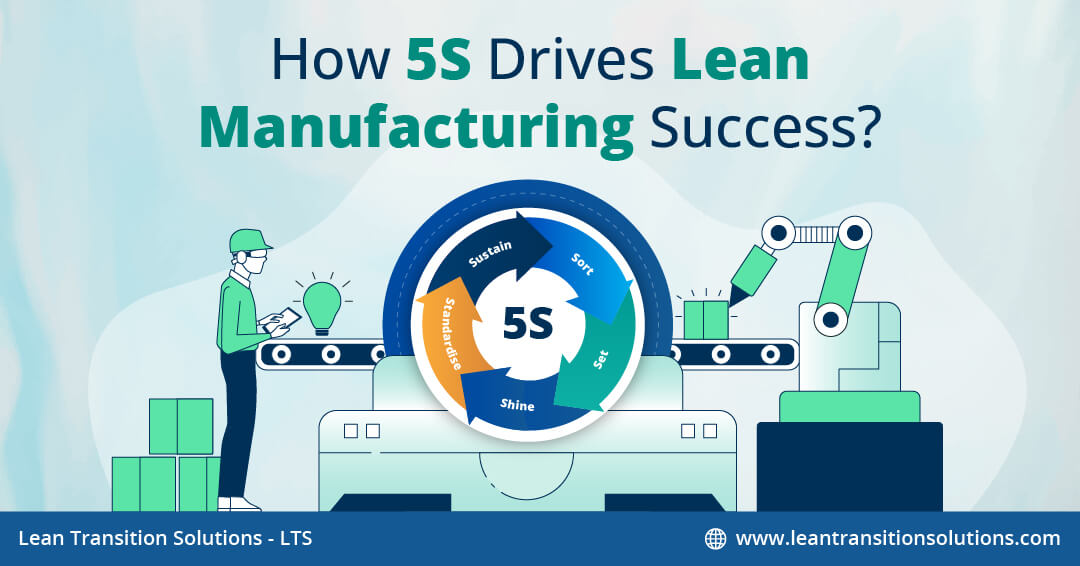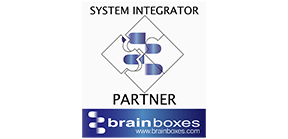How 5S Drives Lean Manufacturing Success?
- By Brett Griffiths
- 5S Process
- February 09 , 2024
- Share

It's not surprising to find the 5S lean manufacturing approach in your quest for shop floor excellence. Organisations constantly seek ways to optimise processes, eliminate waste, and enhance productivity. Helpfully, the 5S framework popularised by TPS (Toyota Production System) can help organisations reduce waste and improve operational efficiency.
5S principles revolutionised how businesses organise their workspaces, streamline operational processes, and foster a continuous improvement culture. Let's discuss the critical importance of adopting 5S principles in manufacturing processes to ensure operational excellence.
What is the 5S Lean concept?
5S Lean manufacturing is a concept, derived from the Japanese terms "Seiri, Seiton, Seiso, Seiketsu, and Shitsuke," represents a systematic methodology within Lean manufacturing to optimise workplace efficiency and organisation. The 5S pillars form the foundation of a systematic approach that enhances continuous improvement in various industries, particularly in Lean manufacturing.
- Sort (Seiri): This pillar systematically eliminates unnecessary items from the workspace, promoting efficiency and visual clarity. By discerning between essential and non-essential items, organisations reduce clutter and optimise the use of resources. For example, in a manufacturing industry, regularly auditing tools and materials ensures that only essential items are retained at workstations, minimising the risk of errors and delays.
- Set in Order (Seiton): Focused on organisation, Seiton is about logically arranging the remaining items. This enhances accessibility, minimises search time, and streamlines workflows. For instance, implementing a colour-coded system for tools or creating designated storage spaces for equipment ensures that everything has a designated place, reducing downtime associated with misplaced items.
- Shine (Seiso): Emphasising cleanliness and maintenance, Seiso creates a safer and more productive environment. Regular cleaning routines and equipment maintenance contribute to a visually appealing workspace and prevent safety hazards. For example, in a manufacturing facility, this could involve daily machinery cleaning to prevent malfunctions and ensure a safe working environment for employees.
- Standardise (Seiketsu): This pillar involves establishing consistent practices and procedures to sustain the improvements achieved through sorting, setting in order, and shining. Standardisation ensures that the benefits of the first three pillars are maintained over time. For instance, creating and implementing Standard Operating Procedures (SOPs) for daily cleaning routines or organising tools helps embed these practices into the regular workflow.
- Sustain (Shitsuke): The commitment to maintaining 5S practices over the long term, fostering a culture of continuous improvement. This involves training, regular audits, and reinforcement of the 5S principles. In practice, sustaining might involve ongoing employee training, periodic audits to ensure compliance, and recognition programs to incentivise adherence to 5S principles, thereby embedding them into the organisational culture for lasting impact.
When effectively implemented, Lean 5S improves workplace organisation, visual management and production efficiency while reducing waste and fostering a continuous improvement culture within the broader Lean manufacturing framework.
The 6th 'S' - Prioritising Workplace Safety
The extension of the 5S methodology to form '6S' by incorporating "Safety" represents a strategic enhancement that gives critical importance to a secure and healthy work environment. As the sixth element, safety elevates the 5S framework to a new level where the workforce's well-being is prioritised, reducing the risk of accidents and injuries. By cultivating a workplace culture prioritising safety, organisations protect their most valuable asset—their employees—and contribute to improved morale, enhanced productivity, and long-term sustainability.
Why is 5S important in Manufacturing?
In lean manufacturing, 5S plays a pivotal role in driving efficiency, minimising waste, and fostering continuous improvement. The systematic application of Sort, Set in Order, Shine, Standardise, and Sustain principles optimises workflows, streamlining processes to reduce unnecessary movements and enhance overall productivity. Emphasising workplace organisation and cleanliness, 5S contributes to heightened operational efficiency, improved safety, and a culture of ongoing improvement. As a cornerstone of lean manufacturing practices, 5S enhances organisational performance and establishes a foundation for sustained success in the dynamic landscape of modern manufacturing.
In what way does 5S work with Lean Manufacturing?
The 5S methodology plays a pivotal role in Lean manufacturing by fostering a systematic and organised work environment. Its implementation ensures process efficiency, waste reduction, and continuous improvement in manufacturing processes. Through Sort, Set in order, Shine, Standardise, and Sustain, 5S promotes a streamlined workplace where unnecessary items are eliminated, cleanliness is prioritised, and procedures are standardised.
5S is a systematic approach that aligns seamlessly with Lean principles, as it reduces downtime, enhances productivity, and minimises defects. The synergy between 5S and Lean manufacturing creates a foundation for operational excellence, empowering organisations to achieve optimal workflow and resource utilisation in their manufacturing industries.
How does 5S relate to Kaizen?
5S and Kaizen share a symbiotic relationship, as both these concepts aim for continuous workplace improvement. 5S serves as a foundational methodology within the Kaizen philosophy by providing a systematic approach to organising the workplace and reducing waste. The principles of 5S, when consistently applied, create an environment conducive to Kaizen, fostering a culture of incremental and continuous improvement in processes and efficiency.
A closer look at 5S Implementation in the workplace
Implementing the 5S program is crucial for any industry, irrespective of its operational activities, as it optimises efficiency and fosters a culture of continuous improvement. By prioritising 5S, organisations can create a workplace that minimises waste, enhances productivity, and ensures sustained operational excellence. For a successful 5S implementation in your Lean manufacturing organisation, you can consider following all these relevant steps:
Perform Initial Workplace Assessment
- Conduct a thorough assessment of the current workplace to identify areas for improvement.
- Determine the specific goals and objectives of implementing the 5S program.
Conduct Training Sessions
- Provide comprehensive training to employees on the principles and benefits of 5S.
- Foster a culture of active participation and engagement among all team members.
Sort and Declutter your workplace (Seiri)
- Remove unnecessary items and materials from the workplace.
- Clearly distinguish between essential and non-essential items.
Set in Order for easy access (Seiton)
- Organise tools, equipment, and materials logically and efficiently.
- Implement a visual system for easy identification and retrieval of items.
Ensure Cleanliness by taking relevant measures (Seiso)
- Establish regular cleaning schedules to maintain a clean and safe workplace.
- Encourage employees to take pride in keeping their work areas tidy and well-maintained.
Follow Standardised practices (Seiketsu)
- Develop standardised procedures and guidelines for maintaining an organised workplace.
- Regularly review and update standards to adapt to changing needs.
Execute Regular Audits and Monitor frequently (Shitsuke)
- Conduct regular audits to ensure ongoing compliance with 5S principles.
- Use feedback from audits to make further improvements and adjustments.
Let’s analyse how a workplace looks before and after 5S implementation.
| Aspect | Before 5S Implementation | After 5S Implementation |
| Workplace Organisation | Unsystematic arrangement of workstations. | Workstations organised with clear visual management. |
| Efficiency | Time-consuming search for specific inventory. | Quick retrieval of inventory, minimising downtime. |
| Productivity | Forklifts were frequently misplaced, causing delays in material handling processes. | Forklifts were strategically organised, optimising the material handling workflow. |
| Safety | Loose cables were scattered across the workspace affecting safety. | Cable management systems were implemented to create a safer work environment. |
| Quality | Increased errors and defects in product quality. | Consistent product quality through organised processes. |
| Employee Morale | Frustration among employees due to chaotic workspaces. | Boosted morale as employees work in an organised environment. |
| Costs | Higher expenses associated with unplanned downtime. | Cost savings are achieved through improved efficiency. |
5S tools in Lean Manufacturing Processes
Technology plays a crucial role in automating 5S processes within lean manufacturing environments. Lean 5S audit and assessment solutions are powerful tools to streamline and automate the 5S implementation process. The software solution facilitates efficient 5S audits, ensuring a systematic approach to workplace optimisation. By embracing 5S principles through technology, organisations can align with the goals of Industry 4.0, fostering a digitally driven and continuously improving manufacturing environment.
Environmental Benefits of Lean Manufacturing and 5S Implementation
Embracing 5S principles in organisations enhances operational efficiency and fosters a commitment to sustainability, aligning with global environmental goals. The implementation of 5S in the workplace brings about a range of environmental benefits:
- Waste Reduction: Minimises unnecessary materials and resources, leading to a significant reduction in overall waste generation.
- Energy Efficiency: Streamlining processes and optimising workflows under 5S contribute to reduced energy consumption and alignment with sustainable energy practices.
- Reduced Emissions: 5S contributes to lower greenhouse gas emissions by streamlining operations and minimising inefficiencies, aligning with environmental sustainability goals.
- Resource Conservation: Encourages responsible resource management, promoting the conservation of raw materials and reducing environmental impact.
- Green Practices Culture: Implementing 5S fosters a workplace culture that values sustainability, instilling awareness and encouraging eco-friendly practices among employees.
Embracing automation is essential for implementing 5S principles on your shop floor. Adopting 5S solutions can help streamline your manufacturing process. This synergy between 5S and lean manufacturing processes enhances workplace organisation and safety and positions manufacturing facilities to adapt and thrive in an era of rapid technological advancements. As we navigate the intersection of lean methodologies and advanced technology, the journey towards operational excellence continues, fueled by the principles of efficiency, standardisation, and sustained improvement.
Start Free Trial
LEAN TRANSITION SOLUTIONS
The Old Vicarage, Pershore Road, Upton Snodsbury, Worcester, Worcestershire, WR7 4NR, United Kingdom.
Lean Transition Solution
-
Lean Industry 4.0 Solutions
- TITAN:Computerised Maintenance Management System
- Data Point:Computerised Balanced Scorecard
- Janus: Automated Shop-floor Data Capture System
- T-Card: Integrated Production Planning and Plant Level Execution System
- JDI: Maintenance Automation App
- Maximus: Integrated ERP System
- e-Contractor: Integrated In-house Contractor Management System
- Q-Point: Integrated Quality Management System
- Safety-Point: Integrated Health and Safety Management System
- Lean Assessment: Lean Audit and Assessment System
- Saisho: Lean 5S Audit and Assessment App
- Emergency Response App: To Manage Emergency Situations
-
Leadership 4.0 Solutions
- Your Career Academy(YCA): Learning and Development System
- YCA e-Learning : Management System
- MentorYou(MU): Mentoring App
- Leadership 4.0 : Leadership Transformation Program
- Lean Manufacturing Workshop
- Lean Manufacturing Consulting
- ILM Accredited Green Belt Training and Certification Program
- ILM Accredited Black Belt Training and Certification Program
- Software Development Service
- Resources
- Company
- Contact



